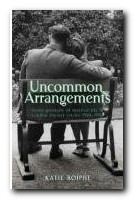studies of five unusual Victorian marriages
Parallel Lives made a big impact when it first appeared, and continues to be a source of inspiration to many biographers. I noticed an appreciative reference to it in Katie Roiphe’s recent study of unconventional literary relationships, Uncommon Arrangements, which deals with similar issues. Phyllis Rose has chosen to write about a series of fairly famous Victorian literary marriages in which the personal relationships were unusual by contemporary standards, and which she believes offer modern readers something to think about in our age of apparent sexual free-for-all.
 And I couldn’t help feeling from hints she drops at regular intervals throughout the book that she was working out some of her own personal issues at the same time. The subjects are Jane Welsh and Thomas Carlyle, Effie Gray and John Ruskin, Harriet Taylor and John Stuart Mill, Catherine Hogarth and Charles Dickens, and George Elliot and George Henry Lewes.
And I couldn’t help feeling from hints she drops at regular intervals throughout the book that she was working out some of her own personal issues at the same time. The subjects are Jane Welsh and Thomas Carlyle, Effie Gray and John Ruskin, Harriet Taylor and John Stuart Mill, Catherine Hogarth and Charles Dickens, and George Elliot and George Henry Lewes.
What she is trying to show is that in an age when marriages were often made as financial and social contracts, the arrangements made to cater for personal satisfaction were often more subtle and successful than we might imagine today, when sexual or romantic reasons are given precedence.
The story of Ruskin’s wedding night fiasco is reasonably well known: the authority on classical beauty took fright when he saw a real woman in the flesh. What is not so well known is that he never consummated the marriage, and after several years of misery, being presented with his failure to deliver as the grounds for divorce, he offered to ‘prove his virility’ in court. How exactly he would have gone about doing this is the source of some amused speculation.
John Stuart Mill’s case is slightly different, although it shared one important feature. He fell in love with Harriet Taylor, whose husband thoughtfully allowed them to carry on their relationship because it was sexually chaste. Even when the tolerant Mr Taylor died and the couple were able to marry, the habit stuck, reinforced by Mill’s belief that men should subjugate themselves to women’s will – in order to compensate for the historical injustices they had suffered.
It’s hard to see why Phyllis Rose included the similarly well-known case of Charles Dickens and his wife Catherine Hogarth, except as she concludes “he provides a fine example of how not to end a marriage”. Their early life together is a portrait of his energy and bonhomie; then comes his disenchantment and the separation. But of the twelve remaining years secretly engaged with Ellen Ternan – nothing is made. Dickens took such rigorous pains to conceal his tracks, there’s still no hard evidence on the degree of their intimacy – though it’s almost impossible to escape the conclusion that it was complete.
Rose makes the case that George Eliot, a woman blessed with high intelligence but not good looks, was forthright and enterprising enough to seek out what she says every normal woman wants – a man to love and be loved by. The man in question was George Henry Lewes, married though separated from his wife. But because his wife had three children by his friend Thornton Hunt, all of them were regarded as scandalous libertines by society at the time. Eliot lived with Lewes happily ‘outside the law’ for twenty-four years, then when he died she married her financial adviser, who was twenty years younger than her.
The strangest case of all is the Carlyles – of whom it was said that the best thing about their being married to each other was that only two people were miserable, not four. In another apparently sexless union, Mrs Carlyle, Jane Welsh, devoted herself to promoting his ‘greatness’ and was treated dreadfully in return. Confiding her unhappiness to a diary which he edited after she died, Thomas Carlyle spent the rest of his life afterwards eaten up by remorse because of the unhappiness he had engendered.
There are plenty of unusual arrangements here, but no easy solutions. Fortunately for us, separation and divorce are much easier in the twenty-first century. But Phyllis Rose wants us to reconsider these examples of Victorian challenges to orthodoxy and view them sympathetically – even when the cost in some cases seemed to be personal happiness and sexual fulfilment.
© Roy Johnson 2002
Phyllis Rose, Parallel Lives, London: Vintage, 1994, pp.320, ISBN: 0099308711
More on lifestyle
More on biography
More on the Bloomsbury Group
